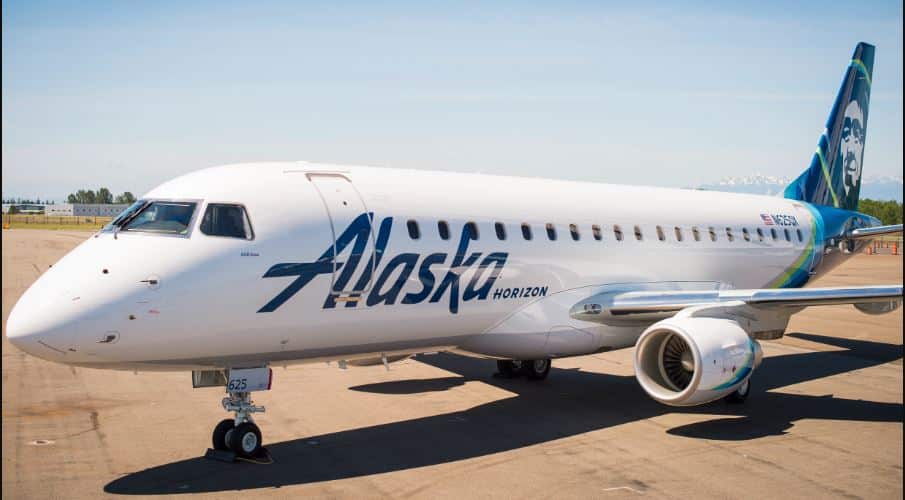Aerospace
Alaska Air Group Orders Eight New E175 Aircraft for Operation with Horizon Air
#Alaska Air Group announced plans to grow its regional fleet with an order of eight new additional E175 jets and options for 13 more

Farnborough, UK, 19 July 2022 – Alaska Air Group announced plans to grow its regional fleet with an order of eight new additional E175 jets and options for 13 more. The E175 aircraft will fly exclusively for Alaska Airlines under a Capacity Purchase Agreement (CPA) with Horizon Air. The value of the contract, including options, is USD $1.12 billion based on list price. Horizon’s new 76-seat aircraft from this order will be delivered in Alaska’s livery and three-class configuration over the next four years starting in Q2 2023.
Mark Neely, VP Americas, Embraer Commercial Aviation, said, “The E175 is the backbone of the US regional network, feeding airport hubs across the country as well as producing the connectivity all communities need to thrive, both economically and socially. While this market is currently under pressure, it is essential that carriers are able to provide these essential services to the entire United States. The Embraer E175, with 85% market share in its segment, is keeping the US on the move and in touch.”
“The E175 is an extremely efficient aircraft,” said Nat Pieper, senior vice president of fleet, finance and alliances for Alaska Airlines. “The jet is the perfect aircraft to serve Horizon’s regional network in the Pacific Northwest and beyond. Our guests will enjoy a consistent, three-class cabin experience as they travel from smaller communities to catch flights across Alaska’s larger hubs or on one of our many global airline partners.”
The Horizon Air 76-seat E175 jet features 12 seats in First Class, 12 in Premium Class and 52 in the Main Cabin. Onboard amenities include free entertainment featuring more than 1,000 movies and TV shows. Additionally, customers seated in First Class enjoy 110-volt power in every seat.
Transitioning to a single jet fleet
Earlier this year, Horizon Air announced it would move to a single fleet of all E175 jets. The carrier currently flies a mix of 31Bombardier Q400 turboprop aircraft and 30 E175s. It will take delivery of 9 E175s over the next year as part of a previous order that also includes 3 deliveries in 2025.With this order by 2026, if not sooner, Horizon will have a fleet of 50 E175s.
With bases in Washington, Oregon, Idaho and Alaska, Horizon serves more than 45 cities throughout the Pacific Northwest, California, the Midwest, and British Columbia and Alberta in Canada.
The Alaska Airlines’ E175 experience:
· Seat pitch is 31 inches in the Main Cabin, 34 inches in Premium Class and between 36 and 38 inches in First Class.
· All guests flying on the E175 will enjoy a window or aisle seat.
· The regional jet is equipped with large overhead bins.
· Maximum cruising altitude: 41,000 feet
· Typical cruising speed: 494 mph

Aerospace
When Ratan Tata was denied entry to the airfield at the Aero India show, he waited

During our visit to Aero India 2019, we had the unexpected opportunity to see Ratan Tata at the event, which was a thrilling moment for us. However, there was a surprising hiccup when the security staff didn’t allow him to enter due to a lack of a security pass.
Despite this, he remained calm and patiently waited for about 20 minutes until a member of the Tata team brought him the required pass, after which he calmly proceeded inside. It was a humbling sight, showcasing his composed demeanor even in such situations.
Ratan Tata ji is not only a renowned industrialist but also a trained pilot, holding a pilot’s license. In 2007, he became the first Indian civilian to fly the F-16 Falcon during the Aero India show in Bangalore—a proud moment for the nation.
His passion for aviation extended beyond flying, as he played a key role in shaping India’s aerospace industry. Under his leadership, Tata ventured into manufacturing and maintaining aerospace components while upholding its legacy of quality. Notably, Tata’s collaboration with Airbus to develop and manufacture the C295 aircraft is a testament to its growing influence in the sector.
-

 Aviation2 months ago
Aviation2 months agoMicrosoft Flight Simulator Raises $3 Million to Bring Back the An-225 Mriya
-

 Airlines2 months ago
Airlines2 months agoQatar Citizens Can Travel to the United States Without a Visa
-

 Aviation2 months ago
Aviation2 months agoQatar Airways bans these new Electronic Devices on plane
-

 Airlines2 months ago
Airlines2 months agoJapan Airlines Rolls Out Free Domestic Flights to International Passengers
-

 Defence2 months ago
Defence2 months agoWhich Country Has the Largest Fleet of Fighter Aircraft?
-

 Airport2 months ago
Airport2 months agoWestern Sydney Airport Welcomes Its First Plane After 6 Years of construction
-

 Travel2 months ago
Travel2 months agoQatar Airways Launches Four Additional Flights from Amsterdam
-

 Aviation2 months ago
Aviation2 months agoDid you know ? Once Boeing 747 carried 1088 passenger in 1991








